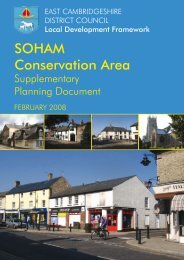East Cambridgeshire District Council Water Cycle Study Detailed ...
East Cambridgeshire District Council Water Cycle Study Detailed ...
East Cambridgeshire District Council Water Cycle Study Detailed ...
Create successful ePaper yourself
Turn your PDF publications into a flip-book with our unique Google optimized e-Paper software.
Stage 2 <strong>Water</strong> <strong>Cycle</strong> <strong>Study</strong>: Final Report<br />
Sept 2011<br />
37<br />
<strong>Cambridgeshire</strong> Horizons<br />
<strong>East</strong> <strong>Cambridgeshire</strong> – <strong>Detailed</strong> WCS<br />
solutions if there is deemed to be no headroom) through a series of workshops . This would<br />
allow some early phasing of allocated and Windfall development (191 dwellings) at a controlled<br />
per annum completion rate, and as such an amber coding has been applied to the first 5 year<br />
delivery timeframe for Burwell (as reflected in section 6.5); this controlled per annum rate would<br />
need to reflect that there are 31 outstanding developments to be built that already have<br />
planning permission in the Burwell WwTW catchment Until a solution is developed for the<br />
allocated and windfall sites, a red category has been applied to growth between 2015 and<br />
2031.<br />
In summary:<br />
• The remaining residual allocated and windfall development proposed for Burwell should be<br />
limited to an annual completion rate agreeable with both AWS and the Environment Agency<br />
up to 2015; It is likely that the 31 outstanding permissions will take any available headroom<br />
that can be identified up to 2012 and hence growth from allocations and windfalls should not<br />
be granted permission without confirmation from AWS and the Environment Agency that<br />
capacity is available up to 2015;<br />
• ECDC should meet monthly with AWS and the Environment Agency to determine a suitable<br />
annual completion rate up to 2015 until a long term solution can be determined;<br />
• ECDC should facilitate workshops with AWS and Environment Agency to develop a long<br />
term solution to be developed in time to implement in the next Asset Management Plan<br />
period (2015 to 2020) to allow all remaining residual growth to take place.<br />
Bottisham WwTW - Solution<br />
Ammoniacal-N standards within the Swaffham Bulbeck Lode will limit the total volume of<br />
effluent that can be discharged at this location. RQP modelling has shown that no further<br />
increases in flow from Bottisham WwTW will be possible without deteriorating from the current<br />
High Status for ammoniacal-N, even when treating at the limits of conventional treatment; an<br />
absolute requirement of the WFD is that there must not be deterioration from the current status.<br />
The modelling has shown that to maintain High Status, only a total of 7m 3 of discharge at a<br />
treatment level of 1mg/l of Amm-N would be possible at this location, equating to 22 homes.<br />
This level is lower than the number of homes already being treated at the WwTW which<br />
suggests that if the WwTW operated at the Ammonia limit set by the new consent recently<br />
issued it would prevent ‘High’ status for ammoniacal-N from being maintained irrespective of<br />
growth. This in turn suggests that either the WwTW currently treats Ammoniacal-N to levels<br />
that are beyond that considered achievable by conventional treatment or that there is a greater<br />
availability of flow and hence dilution in the Swaffham Bullbeck Lode than is calculated using<br />
conventional tools used to determine flow statistics.<br />
There are several options that can be considered as follows:<br />
a) proposed development in Bottisham that has yet to be granted permission be allocated<br />
elsewhere 26 ;<br />
b) an agreement to be reached between the Environment Agency and AWS as to how much<br />
additional growth would be feasible at the WwTW before it would be considered that the<br />
growth would be having additional detrimental impact to that currently caused by existing<br />
flows and flow consents. It has not been possible within this <strong>Detailed</strong> WCS (using the high<br />
level RQP methodology agreed with the Environment Agency) to ascertain an additional<br />
26 50 dwellings of the residual Bottisham target of 136 across the plan period have already been granted permission and hence<br />
cannot be located elsewhere.






